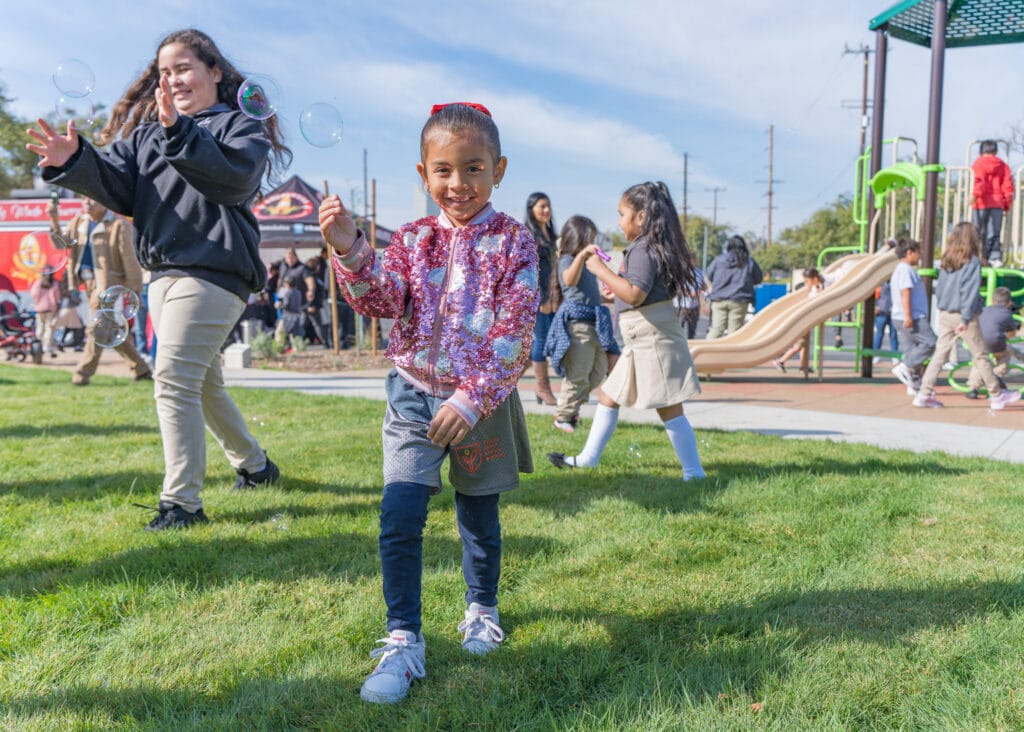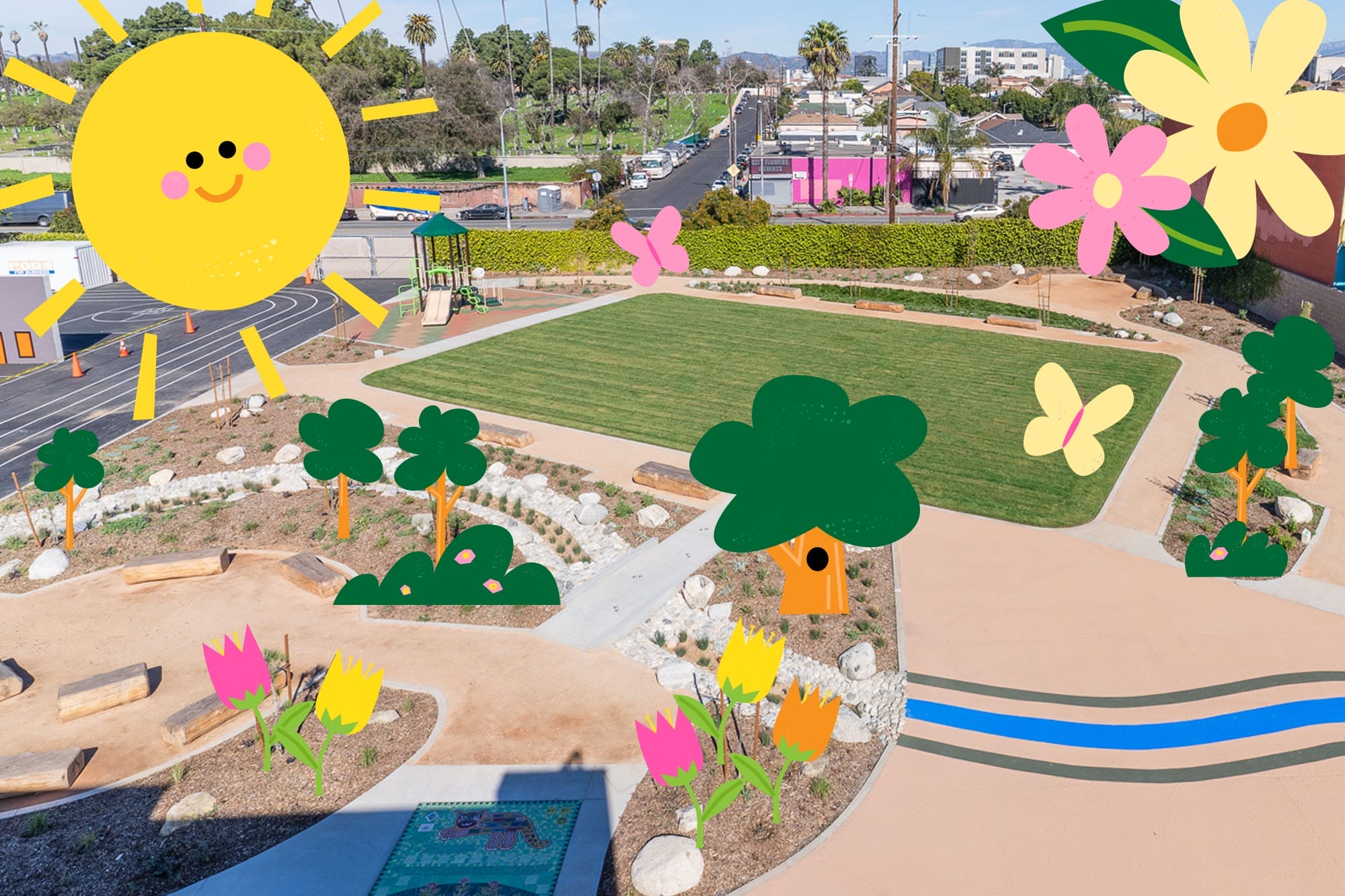Visit Philadelphia’s Bregy Schoolyard, and you’ll see a large, beautiful play space, hear kids playing and laughing. On a summer day, you might feel a hot wind. What you don’t see—what exists below the surface and what it means for this community’s future—is equally important because it could protect the entire neighborhood from increasingly likely catastrophic flooding.
Across the country in L.A., there’s more than meets the eye at Pico-Union’s neighborhood schoolyard. Today, you could almost miss the small forest of two dozen newly planted tree saplings amid the buzz of happy children playing. In 10 years, though, most of the Castellanos Elementary School playground—previously a solid black asphalt hot plate—will be shaded by a lush, cooling canopy of leaves.

Ribbon cutting and grand opening ceremony for the Castellanos Elementary School playground in Los Angeles, California, in early 2024. Photo: TPL staff
But this story is about much more than those two schoolyards or even the 300 others we’ve helped build to date. It’s about the 2 million acres of schoolyards across the United States and building a movement to change the way our country understands and invests in schoolyards to combat climate change threats.
“With the pending threats of climate change—and the ones already here, we as a society . . . have an obligation to prioritize investment in healthy schools. And schoolyards are the most impactful and lowest-cost place to start.”
— Danielle Denk, director of TPL’s Community Schoolyards initiative
The renovations TPL is leading in dozens of communities across the country represent the most ambitious effort by a nonprofit to scale up climate resilience across publicly owned properties that are often in the very heart of communities—where children and adults live and play. They are powerful reminders of the positive impact a relatively small space can have when it’s thoughtfully designed.
The schoolyard renovations achieve far more than climate resilience, of course. They provide children with a vibrant space in which to play during recess, an activity that has become a liability in some places at certain times of year. Community Schoolyards® projects encourage outdoor learning with shaded seating areas and gardens. They provide opportunities for children to have hands-on STEM learning, to harness and analyze the power of nature-based solutions in addressing climate change. And they give the wider community a new green space to enjoy after school and on weekends.
As climate change threatens communities nationwide with dangerously high temperatures and growing flood risks, public schoolyards have emerged as important infrastructure in the quest to make individual neighborhoods and our entire country more resilient. But only if they’re designed with climate resilience in mind and only if they become the standard in every community—urban and rural—across the nation.
Sadly, many existing schoolyards make towns and cities more vulnerable. Devoid of trees and covered in heat-absorbing black asphalt, typical schoolyards flood easily and become dangerously hot.
Working in communities from New York to Tennessee to Oregon, Trust for Public Land has partnered with school districts in both urban and remote rural areas. Regardless of geography, these projects share the same goal: creating healthier environments for young people and communities. That means new play equipment and sports facilities, but also more nature.

Converting asphalt schoolyards into colorful spaces teeming with trees, gardens, artwork, and play features—as TPL did at Alejandrina B. De Gautier Elementary School in Brooklyn—yields all kinds of benefits for students and the wider community, centering on health, education, climate, and park access. Photo: Alexa Hoyer
“We are focusing on communities where children are most vulnerable to the effects of climate change,” says Danielle Denk, TPL’s Community Schoolyards initiative director. “So we’ve grown our programs in Los Angeles and Oakland, California, where heat islands are significant, and in New York and Philadelphia, where flooding is critical. More broadly, we recognize the vital role that schools have in preparing children so they can be successful and so humanity can thrive.”
Rising temperatures, bigger storms, and asphalt schoolyards pose significant risks during recess. Urge Congress to prioritize schoolyards that cool neighborhoods, manage stormwater, and provide opportunities for kids to connect with nature today!
“With the pending threats of climate change—and the ones already here,” she added, “we as a society—and that includes school boards, local governments and nonprofits—have an obligation to prioritize investment in healthy schools. And that includes schoolyards.”’
Brendan Shane, TPL’s climate director, points out that in many towns and cities, schoolyards and school buildings (dominated by asphalt, concrete, stone, and brick) form mini-heat islands. Using satellite imagery and computer modeling, data scientists at TPL found that nationwide, 36 percent of the nation’s 50.8 million public school students attend school in a heat island, which is defined as 1.25 degrees Fahrenheit or more, on average, than the surrounding town or city. The number of days over 90 degrees a student experiences has a direct impact on academic performance, a statistic that is greater in underserved communities and communities of color. By cooling schoolyards, we cool schools and boost student academic performance.
Trees are perhaps the most cost-effective and environmentally friendly defense against searing heat. According to the Environmental Protection Agency, trees and plants lower surface and air temperatures. Shaded surfaces can be 20 to 45 degrees cooler than materials in the full sun. And evapotranspiration, in which trees pull moisture from the soil and release it through their leaves, cools the air directly.
While it can take a while for newly planted trees to grow large enough to create meaningful shade, the wait is well worth it, Shane says. (In the meantime, natural surfaces, shade structures, gazebos, and special paints that reduce heat can help students stay comfortable.) “It’s five, seven, 10 years before you’re throwing more shade,” he notes. “But you want as many trees as you can fit into a space to achieve a robust canopy.”
At Castellanos Elementary School, where the new schoolyard opened at the end of January 2024, students now play tag amid native trees species such as California western sycamore, Torrey pine, desert-willow, and western redbud. Previously asphalt, a new grass field surrounded by mulched native-planting beds and sandy paths will manage stormwater and keep children cooler.
While all of TPL’s Community Schoolyards projects involve planting dozens of trees, a $10 million grant from the U.S. Forest Service’s Urban and Community Forest Program will help TPL accelerate tree plantings and nature-based solutions at even more American schoolyards.
The money will pay for plantings, tree care, and educational programs in schoolyards and surrounding communities across the country, beginning with five cities: Mesa and Chandler, Arizona; Concord, California; Salem, Oregon, and Auburn, New York.
Roomy tree pits, gardens, and vegetated swales capture rainfall too. But for areas prone to severe rainstorms, engineered systems—in which layers of gravel beneath the surface hold water—are sometimes deployed. Such was the case at the F. Amedee Bregy Elementary School in South Philadelphia, where frequent flooding in the neighborhood led to sewage overflows in local waterways. According to a guide to flooding issued by the City of Philadelphia, Pennsylvania has the highest rate of flooding of any state. “When too much water enters the combined sewer system, it can lead to overflows that release billions of gallons of polluted water and diluted sewage into our rivers each year,” the report said.
Bregy’s new schoolyard, which opened last fall, can prevent up to 1.5 million gallons of stormwater—the equivalent of three Olympic-size swimming pools—from overwhelming the schoolyard, the surrounding streets, or the already burdened public sewer system each year.
Kari Sannino, a senior program manager for TPL in Philadelphia, explained that most of the stormwater management was achieved through an underground gravel chamber. “The . . . surfaces are also porous and store runoff,” she says. “This lightens the load on Philly’s overstretched combined sewer infrastructure.”
TPL Community Schoolyards projects in Philadelphia, Camden, and New York City, taken together, divert nearly 70 million gallons of stormwater each year, protecting water quality in the Delaware River, Schuylkill River, Hudson River, East River, and tributaries. “Imagine what would happen if we did this in every city with a combined sewer system,” says Denk.
Greening schoolyards can also mitigate air pollution. That’s because trees capture particulate matter like soot on their leaves and trunks. The pores on a leaf’s surface, too, absorb toxic pollutants. According to the National Park Service, pollutants like sulfur dioxide, carbon monoxide, and ozone are “permanently converted when inside the leaf.”
Pollution is a particular concern at Jennie Reed Elementary School in Tacoma, Washington, where Interstate 5 runs alongside the schoolyard. In the spring of 2024, a TPL-led schoolyard project will open there with dozens of new trees, including Jeffrey pine and hop hornbeam, and thousands of shrubs, flowers, and grasses. (TPL opened another Tacoma schoolyard, at Helen B. Stafford Elementary School, in January, while three more projects are planned; Tacoma has the largest park access gap of any major city in Washington.)
All that vegetation will absorb pollutants that spew from tailpipes whizzing by on the interstate. But the new trees and shrubs are also expected to help Jennie Reed Elementary cope with another form of pollution: noise. “Adding trees to block noise from nearby I-5 will make it easier for students to hear teachers and each other during the school day,” says Abby Sloan, the school’s principal.
From heat to floods to pollution to noise, schoolyards can make a community more resilient and make students more excited about being outdoors. “The evidence is very clear that when kids learn outside, they do better,” Denk says. “They have a higher rate of attendance and academic performance, and they develop problem-solving skills, independence, and confidence. If we can couple that with climate literacy, I think it’s a no brainer.”
Lisa W. Foderaro is a senior writer and researcher for Trust for Public Land. Previously, she was a reporter for the New York Times, where she covered parks and the environment.

Donate to become a member, and you’ll receive a subscription to Land&People magazine, our biannual publication featuring exclusive, inspiring stories about our work connecting everyone to the outdoors.

